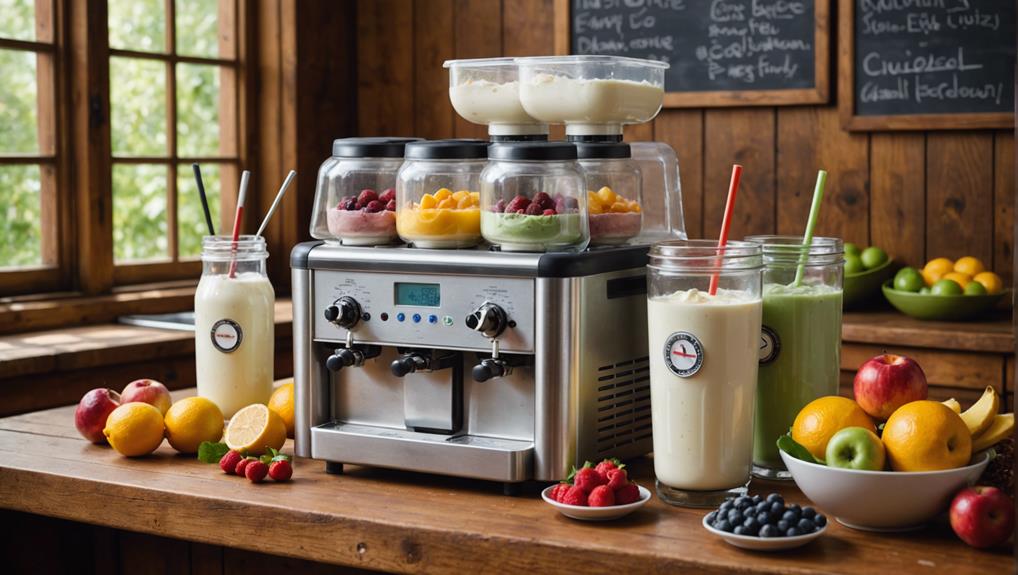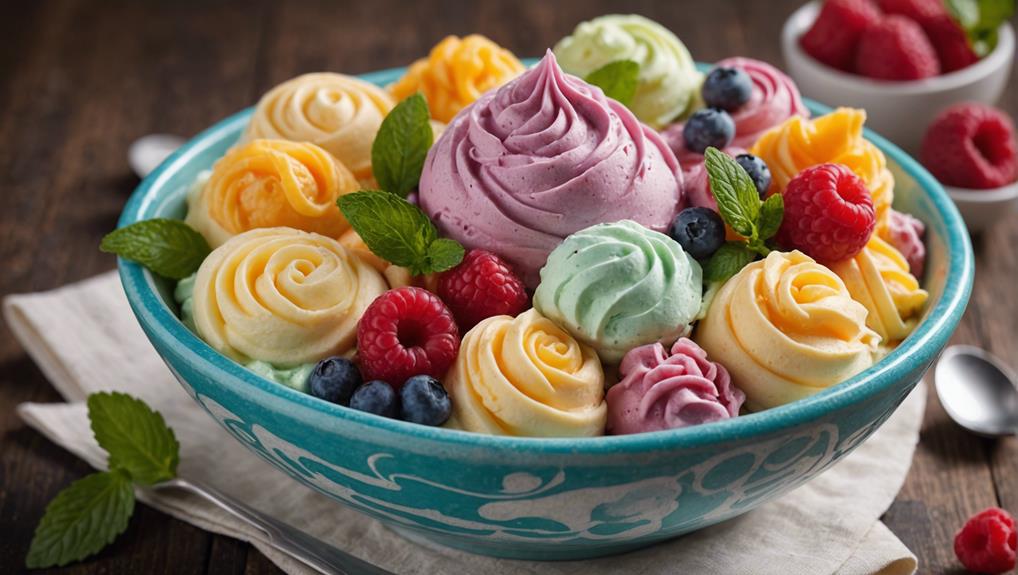Achieving ideal texture and consistency in frozen yogurt necessitates a meticulous balance of stabilizers, controlled air incorporation, and ingredient selection. Critical factors include preventing ice crystal formation through stabilizers, enhancing creaminess via fat content, and reducing water content using dense yogurts like Greek or Turkish varieties. Proper freezing techniques, such as maintaining temperatures around -6 to -8 degrees Celsius and using rapid freezing methods, guarantee a smooth consistency. Incorporation of sugars and fats further inhibits ice crystallization and improves mouthfeel. Ingredient experimentation and straining processes elevate quality, resulting in a superior product. To further explore these detailed methodologies, consider the broader impact of precise techniques.
Key Takeaways
- Dense yogurt enhances frozen yogurt's texture by reducing water content and increasing protein and fat levels.
- Stabilizers prevent ice crystal formation, ensuring a smooth and homogeneous consistency.
- Controlled air incorporation during churning is essential for a consistent texture.
- Optimal freezing temperatures (-6 to -8°C) and rapid freezing techniques produce smaller ice crystals for a smoother texture.
- Higher fat content and the use of high-quality ingredients contribute to a creamier mouthfeel.
Importance of Texture
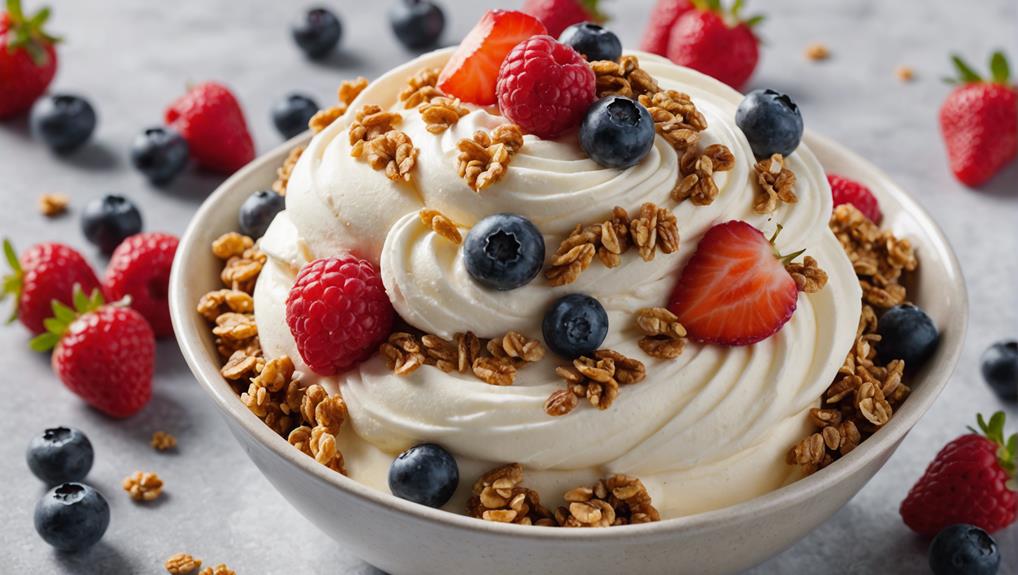
The texture of frozen yogurt is essential as it directly influences the dessert's mouthfeel, quality, and overall sensory appeal. A smooth, creamy consistency is fundamental, ensuring that frozen yogurt is both easy to scoop and pleasurable to consume. Deviations in texture, such as iciness, graininess, or excessive wateriness, detract from the overall experience, rendering the product less desirable.
Empirical data indicates that texture plays a key role in the perception of flavor and sweetness. A uniform texture enhances the distribution of flavor compounds throughout the frozen yogurt matrix, thereby optimizing taste. This relationship underscores the importance of achieving consistent texture through meticulous balance of ingredients, precise freezing techniques, and appropriate use of stabilizers.
Stabilizers, such as guar gum and locust bean gum, play an important role in maintaining textural integrity by preventing the formation of ice crystals and ensuring a homogeneous mixture. Additionally, the incorporation of air during the freezing process, known as overrun, must be carefully controlled to prevent textural inconsistencies. Therefore, the texture of frozen yogurt is not merely an aesthetic consideration but a critical determinant of its overall quality and consumer satisfaction.
Dense Yogurt Benefits
Moreover, dense yogurt offers several advantages in frozen yogurt production, including improved flavor retention due to its reduced water content, which concentrates the taste. Additionally, the thicker consistency contributes to a longer melting time, enhancing the consumer experience. Moreover, the straining process used to achieve dense yogurt increases its nutrient density, offering a product with higher protein and probiotics levels.
Improved Flavor Retention
By utilizing yogurt with reduced water content, frozen yogurt production benefits from enhanced flavor retention and a richer taste profile. Dense yogurt, characterized by its minimized water content, plays a pivotal role in preserving flavor compounds during the freezing process. This reduction in water content mitigates the risk of flavor dilution, a common issue in frozen desserts where ice crystals can compromise the overall taste.
Empirical data suggests that dense yogurt greatly improves the flavor retention in frozen yogurt products. The concentrated nature of dense yogurt guarantees that the intrinsic flavors are not only retained but also intensified, providing consumers with a more robust and satisfying taste experience. This characteristic is particularly advantageous in commercial frozen yogurt production, where consistency in flavor is crucial.
Moreover, the use of dense yogurt contributes to the optimization of the product's organoleptic properties. The rich and intense flavor profile achieved through the incorporation of dense yogurt enhances the sensory appeal of frozen yogurt, making it a preferred choice for both producers and consumers. In conclusion, the strategic use of dense yogurt in frozen yogurt formulations offers substantial benefits in regard to flavor retention and overall product quality.
Longer Melting Time
Leveraging the benefits of dense yogurt not only enhances flavor retention but also noticeably extends the melting time of frozen yogurt products. Dense yogurt, characterized by its elevated protein and fat content, plays a pivotal role in achieving a creamier frozen yogurt. The higher concentration of solids in dense yogurt mitigates ice crystal formation, facilitating a smoother consistency and prolonged melting period. This extended melting time is essential for maintaining product integrity under varying temperature conditions.
The presence of increased fat content in dense yogurt contributes to a richer mouthfeel, further enhancing the sensory attributes of frozen yogurt. Straining processes, which eliminate excess whey, yield a thicker and more viscous yogurt base. This characteristic is instrumental in producing a denser frozen yogurt, which exhibits superior thermal stability.
| Attribute | Dense Yogurt Contribution | Resulting Benefit |
|---|---|---|
| Protein and Fat Content | Higher | Creamier Frozen Yogurt |
| Solids Concentration | Increased | Smoother Consistency |
| Straining Process | Removes Excess Whey | Thicker, More Viscous Yogurt |
Choosing dense yogurt varieties such as Greek or Turkish yogurt can significantly elevate the quality and texture of frozen yogurt, ensuring that it remains enjoyable for a longer duration post-service.
Enhanced Nutrient Density
Incorporating yogurt with higher protein and calcium levels enhances the nutrient density and overall nutritional profile of frozen yogurt products. Dense yogurt, achieved through straining to remove excess whey, results in a thicker consistency and elevated nutrient concentration. This process not only augments the protein content but also increases the presence of beneficial probiotics and essential minerals such as calcium.
The denser texture of strained yogurt substantially contributes to the creamy mouthfeel and richness that consumers expect from high-quality frozen yogurt. Empirical data indicates that dense yogurt with enriched protein levels offers a more satiating product, which can be particularly advantageous for individuals seeking nutritious and satisfying snack options.
Moreover, the integration of dense yogurt in frozen yogurt formulations boosts the nutrient density of the final product, rendering it a superior choice in terms of health benefits. Enhanced protein content supports muscle maintenance and repair, while the increased calcium levels contribute to bone health. The inclusion of probiotics further aids in digestive health, making dense yogurt an invaluable ingredient in the frozen yogurt industry.
Therefore, the use of dense yogurt not only improves the textural properties of frozen yogurt but also significantly elevates its nutritional profile, catering to health-conscious consumers.
Reducing Water Content
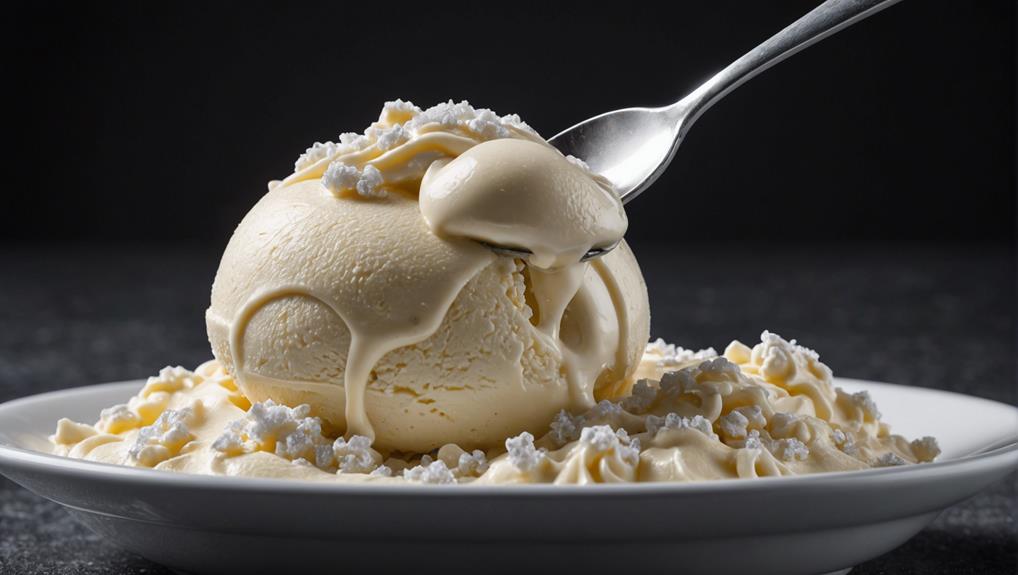
Straining yogurt through cheesecloth or a fine sieve is an essential method for reducing its water content, thereby achieving a thicker consistency. This process is particularly beneficial for frozen yogurt, as lower water content can greatly enhance structural integrity and texture. Greek and Turkish yogurt varieties, known for their naturally denser composition, often serve as the base due to their reduced moisture levels.
The removal of excess whey through straining not only diminishes water content but also concentrates the yogurt's protein and fat content. Empirical data demonstrates that yogurt with decreased whey results in a more viscous consistency, which is important for the desirable mouthfeel in frozen yogurt. Additionally, increased fat content contributes to a creamier texture by interfering with the formation of ice crystals, thus producing a smoother frozen product.
In addition, manipulating the yogurt's composition before freezing, such as by using higher-fat dairy sources, further reduces the water content. This approach mitigates the formation of ice crystals, enhancing the texture and overall quality of frozen yogurt. Controlling water content through strategic straining and ingredient selection is pivotal in achieving the desired frozen yogurt consistency.
Role of Sugar
Sugar notably influences the texture and flavor profile of frozen yogurt by modulating ice crystal formation and enhancing sweetness. The presence of sugar disrupts the crystallization process during freezing, thereby reducing the size of ice crystals and contributing to a smoother, creamier texture. Empirical data suggests that ideal sugar concentrations lead to improved mouthfeel and reduced iciness.
The texture of frozen yogurt is profoundly impacted by the type and amount of sugar used. Variations such as honey, maple syrup, or agave syrup can yield diverse textures and flavor profiles. These sugars also alter the freezing properties, thereby impacting the overall consistency of the final product. For instance, higher sugar content results in a softer, more scoopable texture due to the depression of the freezing point.
- Inhibits ice crystal formation: Smaller ice crystals contribute to a smoother texture.
- Enhances flavor: Different sugars provide unique taste profiles.
- Modifies freezing properties: Higher sugar content affects consistency, making it less icy.
Achieving the desired creamy texture in frozen yogurt necessitates a precise balance of sugar. Insufficient sugar can lead to a grainy consistency, whereas excessive sugar can impair freezing, resulting in an overly soft product.
Adding Fat
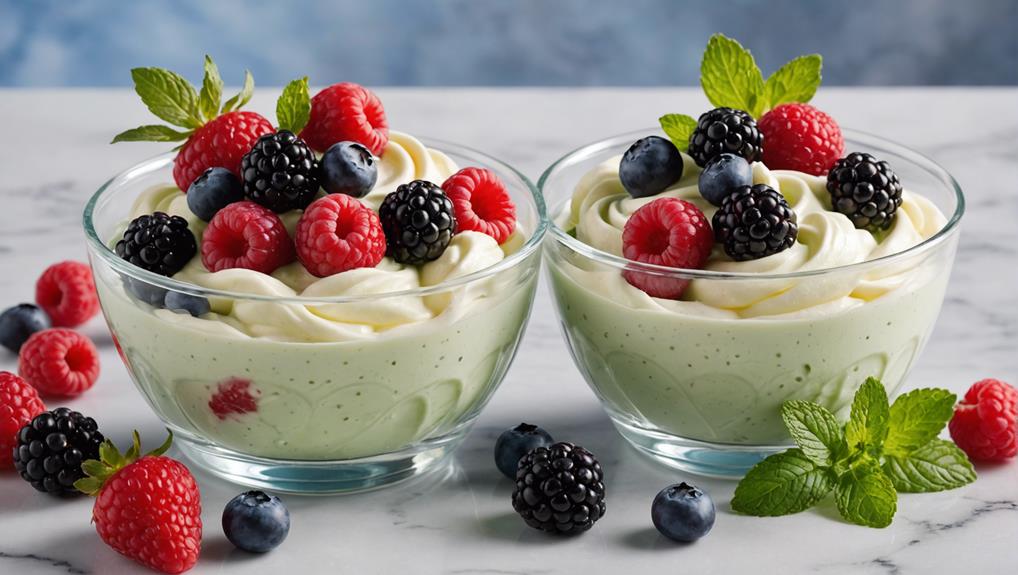
How does the inclusion of fat in frozen yogurt formulations enhance its texture and consistency? Incorporating fat content into frozen yogurt formulations plays a pivotal role in enriching its sensory attributes. Fat contributes to a smoother, more luxurious mouthfeel by interfering with ice crystal formation during the freezing process, resulting in a softer texture. This is due to fat's ability to encapsulate water molecules, thereby slowing down the crystallization process and creating a more stable emulsion.
Common fat sources utilized to improve the texture include cream, mascarpone, and labneh. These ingredients not only augment the richness and creaminess but also introduce subtle flavor nuances that elevate the overall sensory experience. Empirical data indicate that higher fat content correlates with enhanced creaminess and mouthfeel, essential qualities for a premium frozen yogurt product.
Moreover, the incorporation of different fat sources offers opportunities for experimentation, potentially leading to novel and indulgent formulations. By adjusting the fat content, manufacturers can achieve a balanced consistency that meets consumer expectations. Ultimately, the strategic addition of fat serves as a fundamental technique to refine and improve the texture of frozen yogurt, making it more appealing and satisfying to the consumer.
Boosting Solids
Increasing the solid content in frozen yogurt formulations greatly contributes to improved texture and consistency by minimizing ice crystal formation and enhancing a creamier mouthfeel. Solids, including sugar, fat, and other non-liquid ingredients, play a critical role in achieving these desirable characteristics. The augmentation of solid components interferes with ice crystal growth, resulting in a smoother texture and more refined consistency.
Incorporating more sugar not only sweetens the product but also lowers the freezing point, thereby reducing ice crystal size. The role of stabilizers, although discussed in greater detail in subsequent sections, is essential for maintaining the structural integrity of the yogurt matrix. Experimentation with various solid ingredients can yield excellent results, improving the textural quality and overall acceptability of the frozen yogurt.
- Enhanced Creaminess: Higher solid content, particularly fats and sugars, contributes to a richer, creamier mouthfeel.
- Ice Crystal Reduction: Increased solids impede ice crystal formation, ensuring a smoother texture.
- Improved Stability: Properly balanced solid content enhances the structural stability of the frozen yogurt, preventing phase separation.
Adjusting the ratios of these solid constituents, including sugar and stabilizers, can have a significant impact on the final product's sensory and physical attributes, leading to a superior frozen yogurt experience.
Using Stabilizers
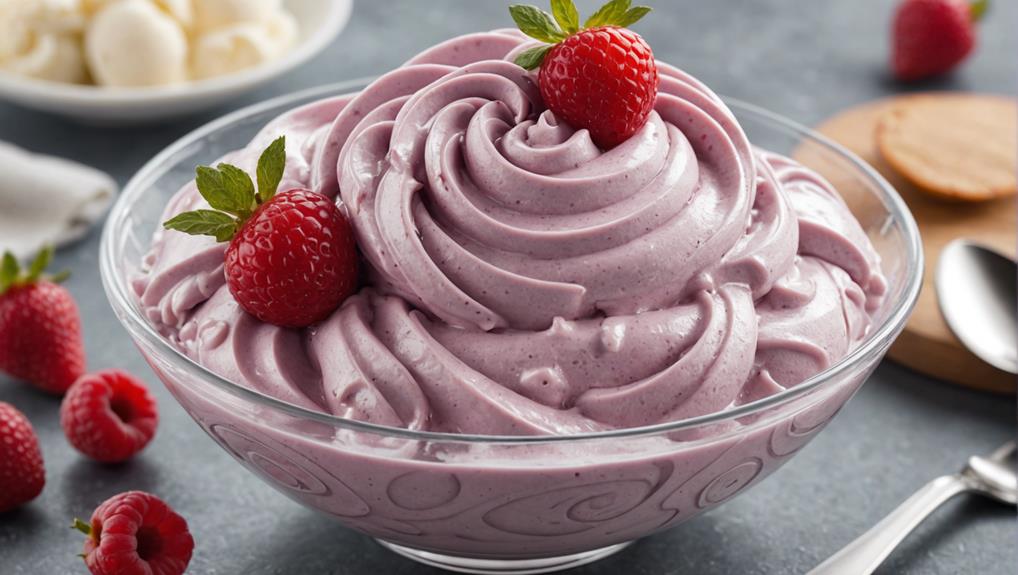
Stabilizers, such as pectin and gelatine, play an essential role in frozen yogurt production by binding water molecules, thereby preventing ice crystal formation and enhancing overall texture and consistency. These additives function primarily by interacting with water molecules, reducing the mobility of free water and hence minimizing the potential for large ice crystal formation during freezing and storage. This mechanism is critical in maintaining the smoothness and creaminess of the final product.
The incorporation of stabilizers not only prevents the development of an icy texture but also contributes to a desirable mouthfeel. By enhancing the viscosity of the yogurt mix, stabilizers improve the structural integrity and creaminess, which are important attributes in consumer preference. Empirical data suggest that a balanced use of pectin and gelatine can notably reduce ice crystal size, resulting in a smoother texture and extended shelf life.
Precise formulation is key; excessive amounts can lead to a gummy texture, while insufficient quantities might fail to prevent ice crystal formation effectively. Hence, a meticulous approach in the selection and dosage of stabilizers is crucial for optimizing the textural attributes of frozen yogurt. This ensures a consistently high-quality product that meets both manufacturing standards and consumer expectations.
Experimenting With Ingredients
Building on the foundational role of stabilizers, experimenting with various ingredients offers a pathway to further refine the texture and consistency of frozen yogurt. Utilizing different yogurt types, such as Greek or Turkish, can yield a denser and more robust texture due to their higher protein content and thicker consistency. Additionally, incorporating inverted sugars, like golden syrup, notably improves the anti-freeze properties of frozen yogurt, mitigating crystallization and enhancing mouthfeel.
To further augment the richness of frozen yogurt, adding cream or other high-fat dairy products can be beneficial. This method increases the fat content, contributing to a creamier texture and improved sensory attributes. Integrating non-liquid flavor ingredients elevates the solid content, thereby stabilizing texture and consistency.
Key considerations for ingredient experimentation include:
- Yogurt Types: Greek or Turkish yogurt for denser texture.
- Inverted Sugars: Golden syrup to enhance anti-freeze properties.
- Additional Dairy: Cream to increase fat content and creaminess.
Achieving Smoothness
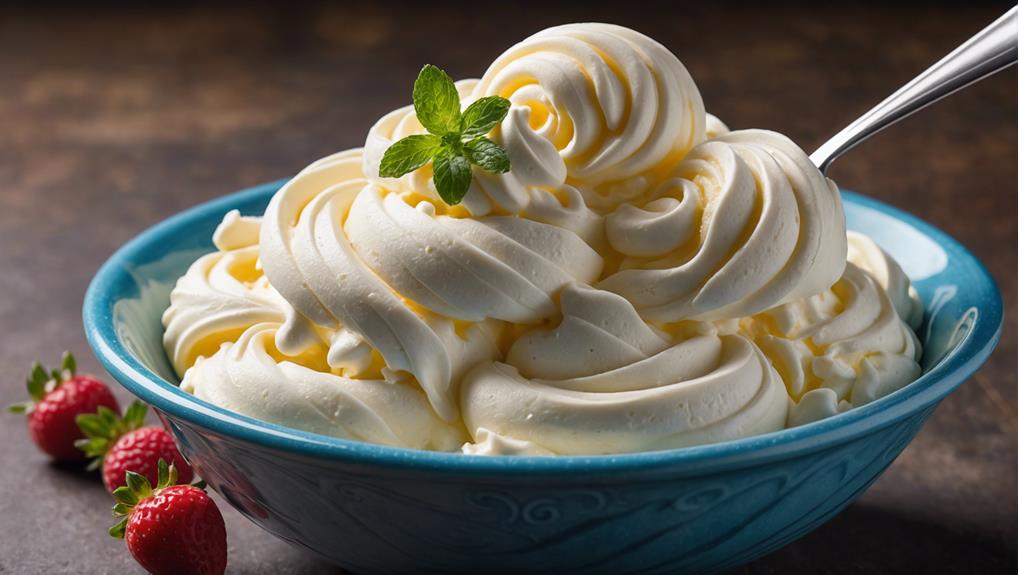
Achieving smoothness in frozen yogurt necessitates attention to ingredient quality, proper churning techniques, and ideal freezing temperatures. High-quality ingredients, such as premium dairy and stabilizers, contribute to a superior texture by minimizing ice crystal formation. Effective churning at controlled speeds and maintaining consistent freezing temperatures guarantee a homogeneous and creamy end product.
Ingredient Quality Matters
Utilizing high-quality ingredients such as full-fat yogurt, cream, and premium fat sources like mascarpone or labneh is essential for achieving a smoother texture and enhanced creaminess in frozen yogurt. The selection of these top-tier ingredients has a profound impact on the end product's mouthfeel and consistency. Full-fat yogurt and cream contribute to a richer, more indulgent texture due to their higher lipid content, which helps to inhibit the formation of ice crystals during freezing. Additionally, premium fat sources like mascarpone or labneh introduce unique flavor profiles and further elevate the creaminess.
Moreover, the inclusion of fresh, high-quality sweeteners like honey or maple syrup can play an important role in improving the overall smoothness by reducing ice crystal formation through their hygroscopic properties. Stabilizers such as gelatine or pectin are also essential in maintaining a consistent and silky texture by preventing phase separation and providing structural integrity.
- Full-fat yogurt and cream: Higher lipid content inhibits ice crystal formation.
- Premium fat sources (mascarpone, labneh): Enhance flavor and creaminess.
- Fresh sweeteners (honey, maple syrup): Reduce ice crystals, improve smoothness.
Experimentation with these ingredients can lead to the development of a velvety and luxurious frozen yogurt consistency, thereby achieving the desired smoothness and texture.
Proper Churning Techniques
While high-quality ingredients lay the foundation for frozen yogurt's texture, proper churning techniques are paramount for achieving smoothness and creaminess in the final product. The churning process, essential for incorporating air into the mixture, directly influences the final texture by creating a light and airy consistency. Employing an ice cream maker effectively guarantees that the frozen yogurt attains the desired velvety texture, contingent upon precise churning parameters.
Empirical data suggests that ideal churning time generally spans 20-30 minutes in an ice cream maker. This duration is vital; under-churning can result in a dense, less palatable product, while over-churning may induce a grainy or icy texture, compromising the quality of the frozen yogurt. The churning techniques must involve a balance, where the mixture is agitated sufficiently to incorporate air, yet not excessively to avoid undesirable textural outcomes.
Adhering to the recommended churning time and methodology facilitates the production of a consistently smooth, scoopable frozen yogurt. This precision in technique underscores the importance of controlling variables within the churning process, thereby ensuring the frozen yogurt's texture meets the highest standards of quality and consumer satisfaction.
Optimal Freezing Temperatures
Maintaining the freezing temperature at approximately -6 to -8 degrees Celsius is crucial for producing frozen yogurt with a smooth and creamy texture. This temperature range ensures the formation of small ice crystals, which is vital for achieving the desired consistency. Deviations from these ideal freezing temperatures can lead to textural issues; lower temperatures result in a harder, icy product, while higher temperatures lead to a softer, less structured consistency.
To achieve smoothness, consider the following guidelines:
- Rapid Freezing Techniques: Utilizing liquid nitrogen or specialized ice cream makers can expedite the freezing process, minimizing the formation of large ice crystals.
- Consistent Stirring: Regular agitation during freezing prevents the aggregation of ice crystals, contributing to a velvety texture.
- Chilled Ingredients and Equipment: Ensuring that both the ingredients and equipment are properly chilled before freezing helps maintain consistent temperatures throughout the process.
Empirical data supports that maintaining precise temperature control is crucial for quality frozen yogurt production. By adhering to these ideal freezing temperatures and techniques, manufacturers can consistently produce a product with superior texture. The interplay of temperature, equipment, and methodology underscores the scientific approach necessary for achieving the perfect frozen yogurt.
Enhancing Creaminess
The creaminess of frozen yogurt can be greatly enhanced by incorporating full-fat, lactose-free milk and Greek yogurt, alongside stabilizers like pectin or guar gum to mitigate ice crystal formation. Full-fat milk and Greek yogurt contribute to a richer mouthfeel due to their higher fat content, which aids in creating a smoother texture by reducing the sensation of iciness. Greek yogurt, in particular, adds a denser consistency due to its lower water content and higher protein levels.
In addition to these primary ingredients, the inclusion of golden syrup, an invert sugar, can play an essential role in preventing crystallization, thereby enhancing the overall texture. Empirical studies have shown that invert sugars like golden syrup can effectively interfere with the formation of ice crystals, resulting in a creamier product.
Flavor and texture can be further refined by the addition of Baileys Irish Cream and Himalayan Pink Salt, which not only add unique flavor profiles but also contribute to a more luxurious mouthfeel. Straining the yogurt prior to sweetener addition can also result in a thicker and creamier final product by reducing excess liquid content. Through these techniques, the desired creaminess in frozen yogurt can be consistently achieved.
Frequently Asked Questions
What Is the Texture of Frozen Yogurt?
The texture of frozen yogurt is creamy, smooth, and free from large ice crystals, providing a velvety mouthfeel. This texture complements a wide flavor variety and diverse topping choices, enhancing the overall sensory experience.
How Would You Describe Frozen Yogurt?
Frozen yogurt, a popular dessert, offers health benefits due to its probiotic content and reduced fat levels. It provides a wide flavor variety, from classic vanilla to exotic fruits, catering to diverse taste preferences.
Does Freezing Yogurt Change the Consistency?
Freezing yogurt noticeably changes its consistency due to water crystallization, resulting in an icy texture. The fat content plays a critical role; higher fat content can mitigate crystallization, enhancing the creaminess and scoopability of the frozen product.
Why Is My Frozen Yogurt so Hard?
Why is your frozen yogurt so hard? The issue often stems from low sugar content and incorrect freezing temperature. Insufficient sweeteners and improper freezing conditions can lead to the formation of large ice crystals, resulting in a firmer texture.
Conclusion
The quest for the perfect frozen yogurt texture and consistency is akin to sculpting a masterpiece from marble, where each element—sugar, fat, stabilizers, and ingredient experimentation—chisel away imperfections. By reducing water content and enhancing creaminess, a dense and smooth final product is achieved. The intricate balance of these components, much like the harmony in a symphony, guarantees a delectable treat that resonates with both precision and artistry, elevating the consumer experience to a sublime gastronomic delight.


